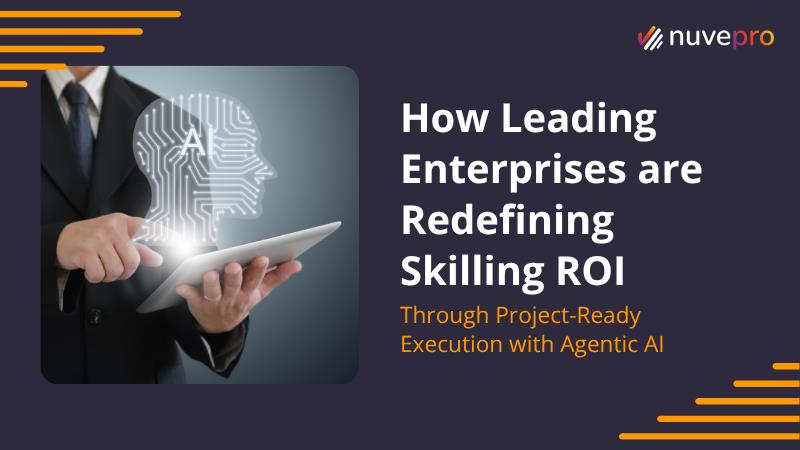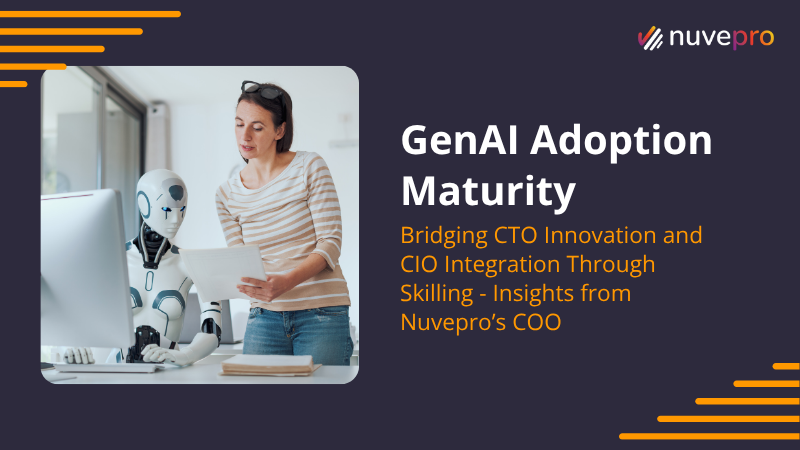The Buzz Around GenAI
Generative AI, or GenAI, is the latest buzzword reverberating through the tech industry. It’s a topic on everyone’s lips, from developers and software professionals to entire tech organizations. The rise of generative AI has caused quite a commotion, and not without reason. While some professionals—about 35%—are worried about the potential impact on their jobs, another 17% are curious about its capabilities and applications. However, the majority see GenAI as a beneficial tool that can promote workforce development by enhancing their technical skills and expanding their abilities. But for many of us, understanding and using GenAI isn’t just about theory; it’s about getting our hands dirty and actually building something. At Nuvepro, we’ve seen this firsthand, especially during our recent GenAI hands-on workshop in partnership with AWS. For those apprehensive professionals, there’s an essential lesson: hands-on learning can unlock more potential than they ever imagined.
Too Much Theory, Too Little Practice?
If you’ve ever tried to learn a new technical skill, you know how overwhelming it can be. The internet is overflowing with resources—tutorials, YouTube videos, and MOOCs—but how much do you really absorb by just reading or watching? The real learning happens when you dive in and start doing it yourself. At Nuvepro, we recognized this gap. We noticed that while many workshops focus on theoretical knowledge, they often fall short on practical application. This realization led us to change our approach.
Our GenAI Workshop: A New Approach
We recently conducted our first GenAI hands-on workshop learning session in partnership with AWS, and it was a game-changer. The idea was simple: take developers through a journey where they could actively engage with the technology. Over 80 participants joined us, and the energy in the room was electric. The task? Build an app to analyze weather data using Amazon Q.
The Challenge: Building an App with Amazon QD
Participants from esteemed universities and developers from top companies like Tata Consultancy Services, Virtusa, Tech Mahindra, Capgemini, Rakuten, etc had been a part of our GenAI workshop. Everyone had their laptops out, ready to tackle the challenge. The goal was to use Amazon Q, leveraging its powerful CodeWhisperer functionality to generate code. Participants had to cleanse data using Python libraries, render it graphically, and provide user controls for visualization—all by prompting Q to generate the necessary code. It was intense, it was practical, and it was exactly what we needed.
The Magic of Hands-On Learning
There’s something incredibly satisfying about seeing your code come to life. During the GenAI hands on workshop, participants weren’t just passively following along; they were actively solving problems, debugging issues, and learning by doing. The moment when someone finally gets their app to work, the look of accomplishment is priceless. That’s the magic of hands-on learning—it sticks with you in a way that theory alone never can.
Real-World Skills for Real-World Challenges
The focus on hands-on learning isn’t just about building an app; it’s about preparing for real-world challenges. GenAI is set to become a fundamental part of the tech industry, and the demand for skilled professionals is only going to grow. By engaging in practical exercises, developers gain insights that are directly applicable to their jobs. They learn how to navigate complexities, troubleshoot issues, and think critically—skills that are essential in today’s tech landscape.
Innovations at Nuvepro: GenAI sandboxes and Guided Projects
To make this kind of learning accessible, we’ve introduced innovative solutions through our hands-on labs like GenAI sandboxes, and guided projects.
Guided Projects: Taking Learning to the Next Level
Once you’ve got the basics down, it’s time to tackle more complex challenges. Our GenAI sandboxes and guided projects are designed to help you apply what you’ve learned in meaningful ways. For example, you can use Amazon Q to write a chat application from scratch or improve an existing language model by writing better prompts or fine-tuning it with Retrieval-Augmented Generation (RAG). These real world guided projects push the learners to think creatively and develop solutions that have real-world applications.
GenAI sandboxes: Safe Spaces to Experiment
Have you ever watched a video about how Amazon Q (CodeWhisperer) can be used to generate a new function? Why just watch when you can use our hands on labs? Our GenAI sandboxes are preconfigured environments where you can experiment with GenAI tools like Amazon Q without worrying about making mistakes. These sandboxes for AWS Bedrock and sandboxes for Q developer (CodeWhisperer) come with budget and service limits, ensuring a safe and controlled setting for learning. You can explore, test, and refine your skills with confidence.
Leveraging AWS Bedrock and Amazon Q – GenAI sandboxes
At Nuvepro, our hands-on learning solutions are powered by AWS Bedrock and Amazon Q. These tools are at the forefront of GenAI technology, offering robust features and capabilities.
AWS Bedrock: A Comprehensive GenAI Platform
Amazon Bedrock provides all the foundational capabilities needed to consume, fine-tune, deploy, and operationalize GenAI models. It’s secure by design, with data staying within the customer environment and no data used for retraining. Bedrock’s serverless architecture means you don’t have to worry about provisioning infrastructure or scaling—Amazon handles the heavy lifting. It’s customizable, allowing you to fine-tune models to suit your specific needs, and it integrates seamlessly with the AWS ecosystem.
GenAI sandboxes for Amazon Q
Amazon Q is a game-changer for developers. It generates code based on natural language prompts, making it easier to build applications quickly. During our workshop, participants used CodeWhisperer to generate Python code for data cleansing and visualization. It was a powerful demonstration of how GenAI can streamline development processes and enhance productivity.
Leveraging GenAI Sandboxes in Amazon Bedrock and Q Developer (CodeWhisperer) for Enhanced Learning and Innovation
Hands-on experience and experimentation are crucial for mastering new technologies. GenAI Sandboxes offer a unique and powerful way to facilitate this learning process, providing safe and isolated environments where users can test and refine their technical skills without the risk of affecting live systems. At our recent GenAI workshop, we highlighted the transformative potential of sandboxes in two key areas: sandboxes for Amazon Bedrock and sandboxes for Q Developer (CodeWhisperer).
Sandboxes for Amazon Bedrock
Amazon Bedrock is a comprehensive platform that enables users to consume, fine-tune, deploy, and operationalize generative AI models. Its robust features include foundational capabilities, secure by design architecture, serverless operation, customization options, extensibility with the AWS ecosystem, and accessibility for all user personas. One of the standout features of Amazon Bedrock is its sandbox environment.
How Sandboxes for Amazon Bedrock will Help Learners
Experimentation and Innovation: The GenAI sandboxes for Amazon Bedrock allows learners to experiment with different AI models and configurations without the risk of disrupting production environments. This freedom fosters innovation as users can test new ideas and approaches in a safe setting.
Learning and Skill Development: For new learners, Nuvepro’s GenAI sandboxes provide a practical learning space to understand the intricacies of Amazon Bedrock. They can practice fine-tuning models, integrating with AWS services, and deploying applications, which accelerates their learning curve.
Cost Efficiency: As the GenAI sandbox environment is serverless and incurs no costs, learners can explore and develop without worrying about financial implications. This cost-effective approach is particularly beneficial for startups and educational institutions with limited budgets.
Customization and Adaptation: Learners can fine-tune models in the GenAI sandbox to better align with their specific data and domain requirements. This customization ensures that when they move to production, their models are optimized for their unique needs.
Operational Readiness: By simulating deployment scenarios in the GenAI sandbox, learners can anticipate and address potential issues before they arise in a live environment. This proactive approach enhances operational readiness and reduces the risk of downtime.
Sandboxes for Q Developer (CodeWhisperer)
Q Developer, powered by Amazon CodeWhisperer, is another pivotal tool in the generative AI toolkit. CodeWhisperer assists developers by providing AI-driven code suggestions, which streamline the coding process and enhance productivity. The sandbox environment for Q Developer amplifies these benefits, making it an invaluable resource for both novice and experienced developers.
How Sandboxes for Q Developer (Sandboxes for codewhisperer) will Help Learners
Skill Enhancement: GenAI Sandboxes for codewhisperer offer developers a risk-free space to practice using CodeWhisperer. They can experiment with different coding scenarios and receive AI-generated suggestions, which helps them understand how to leverage AI to improve their coding skills.
Accelerated Learning: For learners, the GenAI sandbox environment provides immediate feedback on their coding attempts. This iterative learning process helps them quickly grasp the nuances of coding with AI assistance, thereby speeding up their mastery of the tool.
Error-Free Development: By testing their code in a sandbox, developers can identify and correct errors before deploying their applications. This error-free approach ensures that when the code moves to production, it is robust and reliable.
Collaboration and Sharing: Nuvepro’s GenAI Sandboxes for codewhisperer enable developers to collaborate on real world projects by sharing their sandbox environments. This collaborative approach fosters a community of practice where developers can learn from each other and collectively enhance their technical skills.
Innovative Solutions: The freedom to experiment in Nuvepro’s GenAI sandboxes encourages developers to think creatively and develop innovative solutions. They can try out new coding techniques and integrations with other AWS services, which can lead to groundbreaking applications and services.
The Impact: Building Confidence and Competence
The response to our workshop was overwhelmingly positive. Participants from some of the most renowned enterprises were not only engaged but also excited about the possibilities of GenAI. They left with a deeper understanding of how to apply these tools in their own projects and a newfound confidence in their skills.
A New Way Forward
The success of our GenAI hands-on workshop is a clear indication that this is the way forward. As GenAI continues to evolve, the need for practical, experiential learning will only increase. At Nuvepro, we’re committed to providing these opportunities and ensuring that developers are equipped to meet the challenges of the future.
Conclusion: Join the Hands-On Revolution
If you’re a developer or tech professional looking to upskill, don’t settle for theory alone. Dive into hands-on learning with Nuvepro. Our hands on learning workshops on our hands on labs through our secure sandboxes for AWS Bedrock/ sandboxes for Q developer (CodeWhisperer) are designed to give you the practical experience you need to succeed. GenAI is the future, and with the right skills, you can be a part of it. Join us on this journey and unlock your full potential.
In a world where technology is constantly changing, staying ahead means not just knowing about the latest advancements, but being able to use them. Hands-on learning is the key, and at Nuvepro, we’re here to make sure you have the tools and support you need to thrive.




